| Desc: |
Catalysis of the transfer of a solute or solutes from one side of a membrane to the other according to the reaction: Zn2+(out) = Zn2+(in), probably powered by proton motive force. In high affinity transport the transporter is able to bind the solute even if it is only present at very low concentrations. |














